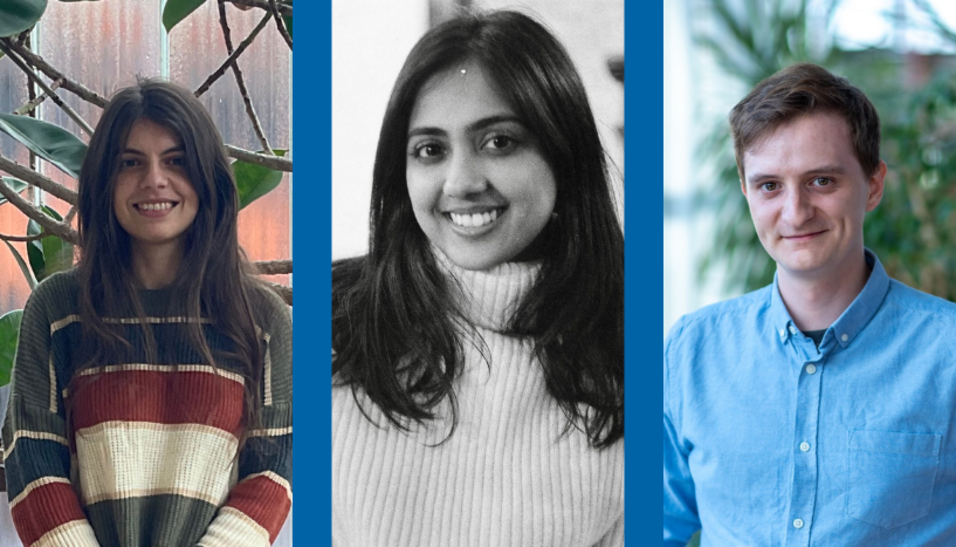Funded by the European Union, the MSCA-PF enhances the creative and innovative potential of excellent postdoctoral researchers who wish to acquire new skills through advanced training, international, interdisciplinary, and inter-sectoral mobility. López Hidalgo and Mathur are among the 10 top-ranked MSCA-PF awarded to the University, based on the score given by the European Commission, and will receive an additional third year of salary.
Cristina López Hidalgo: Biological nitrification inhibition (BNI) of the root exudates under drought stress in wheat
Cristina López Hidalgo did her PhD at the University of Oviedo, in Spain. She joined the Weckwerth Lab, a world-leading lab in metabolomics, plant-microbe interaction and crop research, as a visiting scientist from the University of Oviedo, where she studied the acclimation response to abiotic stress and natural variation of forest trees. Adaptive differences in response to high temperatures and drought, environmental conditions harmful to plants including forest and crop species, seem to be driven by the metabolome and the soil microbiome. Through this methodology called metabolomics the aim of the project is to study how drought affects root exudates of essential crops such as wheat, pearl millet and maize.
In addition to being harmful to crops, drought can hinder the assimilation of nutrients such as nitrogen. Globally, agriculture uses a huge amount of nitrogen fertilizer, about 120 million tons yearly. However, due to soil processes, like nitrification, up to 70 % of this nitrogen isn't taken up by crops and ends up washing away. This causes water pollution and the release of nitrous oxide, a potent greenhouse gas, with a warming effect 298 times stronger than CO2. Crop roots can exudate natural compounds that prevent nitrification, a process known as biological nitrification inhibition (BNI). The discovery of new BNI compounds remains minimally explored in wheat and corn, and root exudate plasticity in response to environmental changes is still extremely limited.
"This project is really exciting because the field of discovery of new BNI compounds is an area in full bloom”, explains López Hidalgo. “Identifying crop ecotypes with greater biological nitrogen fixation capacity serves the dual purpose of potentially reducing nitrogen fertilizer usage, thereby cutting costs, and mitigating environmental harm."
Varsha Mathur: Pirsonia-Coscinodiscus as an emerging marine model system for microbial host-parasite interactions
Varsha Mathur is an evolutionary microbiologist. She did her PhD at the University of British Columbia in Vancouver, Canada, studying the evolution of apicomplexan parasites and then moved to the University of Oxford on an EMBO Fellowship. Her research interests include the evolution of eukaryotic parasites and characterising the diversity and role of parasites in the ocean.
Our understanding of microbial interactions in the ocean is limited in a large part due to a lack of laboratory model systems to study them in depth - one such interaction is parasitism. Although we know that there is a great diversity of parasites in the ocean and that they are important in modulating harmful algal blooms, we still don't know how most of them work, even at a basic cellular level.
During her Marie Curie fellowship, she will develop a new model system comprised of a bloom-forming diatom and it's nanoflagellate parasite. The project will involve using methods like single-cell RNA sequencing and high-resolution microscopy to elucidate the cellular and genetic mechanisms underlying this fascinating interaction.
"I am excited to develop this project in the Technau Lab because they have such strong expertise with developing new marine model systems as exemplified by their beautiful work on the starlet sea anemone", explains Varsha Mathur.
Thomas Davies: Dental morphology across the tooth row: Geometric morphometric analysis of multiple tooth positions, reconstruction of missing teeth, and implications for hominin taxonomy.
Thomas Davies is a paleoanthropologist who works on hominin dental morphology. He did his PhD at the Max Planck Institute for Evolutionary Anthropology, studying the origin and evolution of the genus Homo from a dental perspective. His research investigates the evolution of hominin teeth, exploring the implications for important transitions in the course of human evolutionary history.
Davies uses micro-CT scanning to investigate the internal structure of teeth; while the enamel surface is worn down over an individual’s lifetime, the internal structures often remain well preserved. So, by studying internal dental morphology, we get an insight into the original unworn form of fossil teeth. During his Marie Curie fellowship, Thomas will work with Prof. Philipp Mitteröcker from the Department of Evolutionary Biology to develop a new methodological framework for studying tooth shape across the entire tooth row, rather than focusing on each tooth individually. Fossils are frequently missing teeth, so they will also develop a method of statistically estimating the shape of any missing teeth to reconstruct complete tooth rows.
Thomas Davies says: "This methodology will allow us to maximise the information can gain from fossils, and better understand evolutionary changes across the entire jaw. I’m excited to get started."
About the Marie Skłodowska-Curie Postdoctoral Fellowship
The European Commission’s Marie Skłodowska-Curie Postdoctoral Fellowship Program awards 2-year postdoctoral fellowships to outstanding scientists working in research institutions in EU member states, to support their careers and foster excellence in research.
The selection process evaluates the applicant's achievements and the scientific quality of the project and the host laboratory. The process is highly competitive, with less than 15 percent of applicants receiving a fellowship. On top of a monthly stipend, the fellowship provides research and travel allowances, and the program organizes a yearly meeting.
Further reading:

